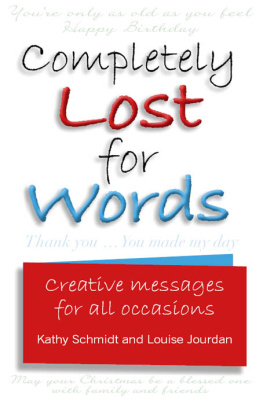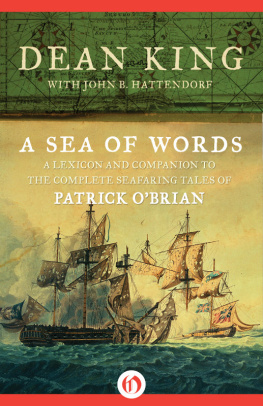Kathy Steinemann - The Writer’s Lexicon Volume II: More Descriptions, Overused Words, and Taboos
Here you can read online Kathy Steinemann - The Writer’s Lexicon Volume II: More Descriptions, Overused Words, and Taboos full text of the book (entire story) in english for free. Download pdf and epub, get meaning, cover and reviews about this ebook. year: 0, genre: Detective and thriller. Description of the work, (preface) as well as reviews are available. Best literature library LitArk.com created for fans of good reading and offers a wide selection of genres:
Romance novel
Science fiction
Adventure
Detective
Science
History
Home and family
Prose
Art
Politics
Computer
Non-fiction
Religion
Business
Children
Humor
Choose a favorite category and find really read worthwhile books. Enjoy immersion in the world of imagination, feel the emotions of the characters or learn something new for yourself, make an fascinating discovery.
- Book:The Writer’s Lexicon Volume II: More Descriptions, Overused Words, and Taboos
- Author:
- Genre:
- Year:0
- Rating:3 / 5
- Favourites:Add to favourites
- Your mark:
- 60
- 1
- 2
- 3
- 4
- 5
The Writer’s Lexicon Volume II: More Descriptions, Overused Words, and Taboos: summary, description and annotation
We offer to read an annotation, description, summary or preface (depends on what the author of the book "The Writer’s Lexicon Volume II: More Descriptions, Overused Words, and Taboos" wrote himself). If you haven't found the necessary information about the book — write in the comments, we will try to find it.
The Writer’s Lexicon Volume II: More Descriptions, Overused Words, and Taboos — read online for free the complete book (whole text) full work
Below is the text of the book, divided by pages. System saving the place of the last page read, allows you to conveniently read the book "The Writer’s Lexicon Volume II: More Descriptions, Overused Words, and Taboos" online for free, without having to search again every time where you left off. Put a bookmark, and you can go to the page where you finished reading at any time.
Font size:
Interval:
Bookmark:
I grew up loving words. My parents were bothIvy League college professors with PhDs in English Literature andClassics. Debates at the family dinner table were often solved bybringing out our huge two-volume compact version of the OxfordEnglish Dictionary (the one with the magnifying glass). My parentsfelt that disputes often came from miscommunication and misuse oflanguage. So wed ferret out the roots of a word in order to pindown its precise meaning and understand its nuances andconnotations. Kathys books help a writer explore thosenuances and connotations in order to choose the perfect word forany occasion with precision and creativity.
And you dont need a magnifying glass. Unlike a standardthesaurus, The Writers Lexicon provides words in context as well as dozens ofexamples of usage. It also offers alternatives for overused wordsand phrases as well as edited examples of ways to enliven yourwriting by choosing exactly the right word. The WritersLexicon is unique in its scope andhelpfulness. (It even provides writing prompts to jumpstart yourstorytelling.) Its a boon to all writers, whether they writefiction or nonfiction. When she visited our writing blog, Kathyoffered a sample from this book in her post Filter Words andPhrases to Avoid in Writing Fiction.
It received 5000 hits per dayfor five days straightthe biggest five-day readership we have everhad on our multi-award winning blog. Logophiles and writers, this is a bookyoull turn to again and again. Enjoy! Anne R. Allen is anaward-winning blogger and the author of twelve books, including thebestselling Camilla RandallMysteries . Shes the co-author, withCatherine Ryan Hyde, of How to be a Writerin the E-Age: A Self-Help Guide , and hasrecently published The Author Blog: EasyBlogging for Busy Authors with Kotu BeachPress. Anne blogs with New York Times million-seller RuthHarris at Anne R.
Allens Blogwith RuthHarris ( annerallen.com ), which was named one of the 101 Best Websites for Writersby Writers Digest.
They becamethe basis for The Writers Lexicon VolumeII: More Descriptions, Overused Words, and Taboos. As you write, realize that dialogue trumpsso-called writing rules. People come from various backgrounds andprofessions. Readers wont expect a preschooler to use perfectgrammar, nor will they tolerate a thug who communicates like auniversity professor. When not writing, pay attention toeverything and everyone around you. Jot down ideas or dictate theminto your cell phone before they escape your busy brain.
Sprinkled throughout these chapters youllfind exercises and examples with ideas for story prompts. Snap emup at will, and write on. P.S. Near the end of thisbook youll find a Master Table of Contents that lists the chaptersof both volumes of The WritersLexicon . You can also download a PDFversion of the Master ToC at: https://kathysteinemann.com/toc.pdf
Rule 1: Do not use semicolons. Kurt Vonnegut saidin A Man Without aCountry : First rule: Do not usesemicolons. All they do is show youve been tocollege. Then he flaunted a semicolon pages later inthe same book: Those of us who had imagination circuits built canlook in someones face and see stories there; to everyone else, aface will just be a face. He went on to say: And there, Ive justused a semicolon, which at the outset I told you never to use. Itis to make a point that I did it.
The point is: Rules only take usso far, even good rules. Maybe the rule shouldbe: Avoid semicolons. Rule 2: Avoid present tense. Present tense jars readers, and although itcan make a story seem more immediate, it works best whencontrasting with events that happened in the past. The Hunger GamesTrilogy by Suzanne Collins and Divergent Series byVeronica Roth are written in present tense. Although I enjoyed thebooks, I was reminded on every page that I felt uneasy.
In Allegiant, thethird Divergent book, head-hopping and first-person present tense made itdifficult at times to remember whose head I was in. Present tense seems almost a fad nowadays.Will it die the same death as pet rocks? Rule 3: Avoid adverbs. Mark Twains advice: If you see an adverb,kill it. Stephen Kings opinion: The adverb is notyour friend. Adverbs, like the passive voice, seem to have beencreated with the timid writer in mind. But the works of both writers includeoccasional adverbs.
Consider The Adventures of Tom Sawyer by Mark Twain: Amy chatted happily along and then stepped quickly but cautiously And Mile 81 by Stephen King: The stone on Carlas chestwas suddenly gone. and began topedal slowly toward the end of Murphy Street. Conclusion: Adverbs may improve writing ifdeployed with caution. Rule 4: Avoid lengthy descriptions of placesand events. Description functions like any othercreativity tool. In moderation, it performs well.
However, too muchdetail may engender purple prose and plodding narrative. Skeptical? Study the following: Susan stepped into the brightly lit kitchenand tucked a lock of long espresso-brown hair behind one ear. Theluscious fragrance of garlic, ground beef, and dill in Altonshomemade tomato spaghetti sauce wafted into her nostrils, evoking astrong memory of its delicious taste. The bubbling sauce spat ahissing red globule onto the glass cooktop of the stove. Herfingers trailed over the smooth surface of the newly remodeledcenter island. Mmm, smells good, she murmured as she nibbled onhis neck.
By the way, your mom just texted me. Shell be about anhour late. The paragraph stimulates all fivesensessight, smell, taste, hearing, touchbut is there a reasonfor so many words? The situation is simple. Susan wants to informAlton his mom will be an hour late for dinner. Hes makingspaghetti. Maybe she can catch him before he boils the water forthe pasta.
Shes in a hurry. Reducing the flowery prose will speedthe narrative: Susan hurried into the kitchen. Mmm. Thatsmells delish, she said, as Altons bubbling spaghetti sauce spata hissing globule onto the stove, but your mom just texted me.Shell be an hour late. A reduction in words speeds to the crux ofthe paragraph. Comprehensive descriptions are critical infantasy and science fiction.
However, a detailed account of aMcDonalds restaurant in a modern-era novel? Not so much. Conclusion: This rule is practical whenemployed judiciously. Rule 5: Avoid detailed descriptions ofcharacters. This dovetails with Rule 4. Although readers usually dont need to knowabout every clothing wrinkle or the brand of a persons shoes, theyrequire enough description to form a mental picture. Thatdescription should occur when characters are introduced, beforereaders develop their own ideas of what they look like.
Font size:
Interval:
Bookmark:
Similar books «The Writer’s Lexicon Volume II: More Descriptions, Overused Words, and Taboos»
Look at similar books to The Writer’s Lexicon Volume II: More Descriptions, Overused Words, and Taboos. We have selected literature similar in name and meaning in the hope of providing readers with more options to find new, interesting, not yet read works.
Discussion, reviews of the book The Writer’s Lexicon Volume II: More Descriptions, Overused Words, and Taboos and just readers' own opinions. Leave your comments, write what you think about the work, its meaning or the main characters. Specify what exactly you liked and what you didn't like, and why you think so.






